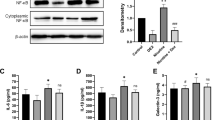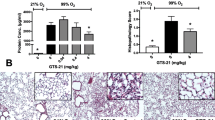Abstract
Activation of the cholinergic anti-inflammatory pathway through direct activation of nicotinic acetylcholine receptors on immune cells can inhibit pro-inflammatory chemokine and cytokine release and thereby protect in a variety of inflammatory diseases. The aim of this study was to investigate whether nicotine treatment protected against acute lung inflammation. Mice challenged with intratracheal lipopolysaccharide (LPS, 50 μg) were treated with nicotine (0.2 or 0.4 mg/kg, sc). After 24 h, bronchoalveolar lavage fluid (BALF) was obtained to measure leukocyte infiltration, lung edema, and pro-inflammatory chemokine (MIP-1α, MIP-2, and eotaxin) and cytokine (IL-1, IL-6, and TNF-α) levels. Nicotine treatment reduced the LPS-mediated infiltration of leukocytes and edema as evidenced by decreased BALF inflammatory cells, myeloperoxidase, and protein. Nicotine also downregulated lung production of pro-inflammatory chemokines and cytokines. These data support the proposal that activation of the cholinergic anti-inflammatory pathway may represent a useful addition to the therapy of acute respiratory distress syndrome.



Similar content being viewed by others
References
Artigas, A., G.R. Bernard, J. Carlet, et al. 1998. The American-European Consensus Conference on ARDS, part 2. Ventilatory, pharmacologic, supportive therapy, study design strategies and issues related to recovery and remodeling. Intensive Care Medicine 24: 378–398.
Kollef, M.H., and D.P. Schuster. 1995. The acute respiratory distress syndrome. The New England Journal of Medicine 332: 27–37.
Abraham, E., A. Carmody, R. Shenkar, and J. Arcaroli. 2000. Neutrophils as early immunologic effectors in hemorrhage- or endotoxemia-induced acute lung injury. American Journal of Physiology. Lung Cellular and Molecular Physiology 279: L1137–L1145.
Strieter, R.M., S.L. Kunkel, M.P. Keane, and T.J. Standiford. 1999. Chemokines in lung injury: Thomas A. Neff Lecture. Chest 116: 103S–110S.
Meduri, G.U., S. Headley, G. Kohler, et al. 1995. Persistent elevation of inflammatory cytokines predicts a poor outcome in ARDS. Plasma IL-1 beta and IL-6 levels are consistent and efficient predictors of outcome over time. Chest 107: 1062–1073.
Takala, A., I. Jousela, O. Takkunen, et al. 2002. A prospective study of inflammation markers in patients at risk of indirect acute lung injury. Shock 17: 252–257.
Peng, X., R.E. Abdulnour, S. Sammani, et al. 2005. Inducible nitric oxide synthase contributes to ventilator-induced lung injury. American Journal of Respiratory and Critical Care Medicine 172: 470–479.
Borron, P., J.C. McIntosh, T.R. Korfhagen, J.A. Whitsett, J. Taylor, and J.R. Wright. 2000. Surfactant-associated protein A inhibits LPS-induced cytokine and nitric oxide production in vivo. American Journal of Physiology. Lung Cellular and Molecular Physiology 278: L840–L847.
Tracey, K.J. 2007. Physiology and immunology of the cholinergic antiinflammatory pathway. The Journal of Clinical Investigation 117: 289–296.
Borovikova, L.V., S. Ivanova, M. Zhang, et al. 2000. Vagus nerve stimulation attenuates the systemic inflammatory response to endotoxin. Nature 405: 458–462.
van Westerloo, D.J., I.A. Giebelen, S. Florquin, et al. 2005. The cholinergic anti-inflammatory pathway regulates the host response during septic peritonitis. The Journal of Infectious Diseases 191: 2138–2148.
Wittebole, X., S. Hahm, S.M. Coyle, A. Kumar, S.E. Calvano, and S.F. Lowry. 2007. Nicotine exposure alters in vivo human responses to endotoxin. Clinical and Experimental Immunology 147: 28–34.
Wang, H., M. Yu, M. Ochani, et al. 2003. Nicotinic acetylcholine receptor alpha7 subunit is an essential regulator of inflammation. Nature 421: 384–388.
de Jonge, W.J., E.P. van der Zanden, F.O. The, et al. 2005. Stimulation of the vagus nerve attenuates macrophage activation by activating the Jak2-STAT3 signaling pathway. Nature Immunology 6: 844–851.
de Jonge, W.J., and L. Ulloa. 2007. The alpha7 nicotinic acetylcholine receptor as a pharmacological target for inflammation. British Journal of Pharmacology 151: 915–929.
Eliakim, R., F. Karmeli, D. Rachmilewitz, P. Cohen, and A. Fich. 1998. Effect of chronic nicotine administration on trinitrobenzene sulphonic acid-induced colitis. European Journal of Gastroenterology & Hepatology 10: 1013–1019.
Karban, A., and R. Eliakim. 2007. Effect of smoking on inflammatory bowel disease: Is it disease or organ specific? World Journal of Gastroenterology 13: 2150–2152.
Mabley, J.G., P. Pacher, G.J. Southan, A.L. Salzman, and C. Szabo. 2002. Nicotine reduces the incidence of type I diabetes in mice. The Journal of Pharmacology and Experimental Therapeutics 300: 876–881.
Carlsson, S., K. Midthjell, and V. Grill. 2004. Smoking is associated with an increased risk of type 2 diabetes but a decreased risk of autoimmune diabetes in adults: an 11-year follow-up of incidence of diabetes in the Nord-Trondelag Study. Diabetologia 47: 1953–1956.
Shi, F.D., W.H. Piao, Y.P. Kuo, D.I. Campagnolo, T.L. Vollmer, and R.J. Lukas. 2009. Nicotinic attenuation of central nervous system inflammation and autoimmunity. Journal of Immunology 182: 1730–1739.
van Maanen, M.A., M.C. Lebre, T. van der Poll, et al. 2009. Stimulation of nicotinic acetylcholine receptors attenuates collagen-induced arthritis in mice. Arthritis and Rheumatism 60: 114–122.
Mishra, N.C., J. Rir-Sima-Ah, R.J. Langley, et al. 2008. Nicotine primarily suppresses lung Th2 but not goblet cell and muscle cell responses to allergens. Journal of Immunology 180: 7655–7663.
The, F.O., G.E. Boeckxstaens, S.A. Snoek, et al. 2007. Activation of the cholinergic anti-inflammatory pathway ameliorates postoperative ileus in mice. Gastroenterology 133: 1219–1228.
Mabley, J.G., P. Pacher, and C. Szabo. 2009. Activation of the cholinergic antiinflammatory pathway reduces ricin-induced mortality and organ failure in mice. Molecular Medicine 15: 166–172.
Bradford, M.M. 1976. A rapid and sensitive method for the quantification of microgram quantities of protein utilizing the principle of protein-dye binding. Analytical Biochemistry 72: 248–254.
Mabley, J.G., P. Pacher, L. Liaudet, et al. 2003. Inosine reduces inflammation and improves survival in a murine model of colitis. American Journal of Physiology. Gastrointestinal and Liver Physiology 284: G138–G144.
Liaudet, L., J.G. Mabley, P. Pacher, et al. 2002. Inosine exerts a broad range of antiinflammatory effects in a murine model of acute lung injury. Annals of Surgery 235: 568–578.
Liaudet, L., P. Pacher, J.G. Mabley, et al. 2002. Activation of poly(ADP-ribose) polymerase-1 is a central mechanism of lipopolysaccharide-induced acute lung inflammation. American Journal of Respiratory and Critical Care Medicine 165: 372–377.
Rosas-Ballina, M., M. Ochani, W.R. Parrish, et al. 2008. Splenic nerve is required for cholinergic antiinflammatory pathway control of TNF in endotoxemia. Proceedings of the National Academy of Sciences of the United States of America 105: 11008–11013.
Gwilt, C.R., L.E. Donnelly, and D.F. Rogers. 2007. The non-neuronal cholinergic system in the airways: An unappreciated regulatory role in pulmonary inflammation? Pharmacology & Therapeutics 115: 208–222.
Su, X., J.W. Lee, Z.A. Matthay, et al. 2007. Activation of the {alpha}7 nAChR reduces acid-induced acute lung injury in mice and rats. American Journal of Respiratory Cell and Molecular Biology 37: 186–192.
Pavlov, V.A., W.R. Parrish, M. Rosas-Ballina, et al. 2009. Brain acetylcholinesterase activity controls systemic cytokine levels through the cholinergic anti-inflammatory pathway. Brain, Behavior, and Immunity 23: 41–45.
Hofer, S., C. Eisenbach, I.K. Lukic, et al. 2008. Pharmacologic cholinesterase inhibition improves survival in experimental sepsis. Critical Care Medicine 36: 404–408.
Parrish, W.R., M. Rosas-Ballina, M. Gallowitsch-Puerta, et al. 2008. Modulation of TNF release by choline requires alpha7 subunit nicotinic acetylcholine receptor-mediated signaling. Molecular Medicine 14: 567–574.
Yoshikawa, H., M. Kurokawa, N. Ozaki, et al. 2006. Nicotine inhibits the production of proinflammatory mediators in human monocytes by suppression of I-kappaB phosphorylation and nuclear factor-kappaB transcriptional activity through nicotinic acetylcholine receptor alpha7. Clinical and Experimental Immunology 146: 116–123.
Sugano, N., K. Shimada, K. Ito, and S. Murai. 1998. Nicotine inhibits the production of inflammatory mediators in U937 cells through modulation of nuclear factor-kappaB activation. Biochemical and Biophysical Research Communications 252: 25–28.
Ware, L.B. 2006. Pathophysiology of acute lung injury and the acute respiratory distress syndrome. Seminars in Respiratory and Critical Care Medicine 27: 337–349.
Blanchet, M.R., E. Israel-Assayag, and Y. Cormier. 2004. Inhibitory effect of nicotine on experimental hypersensitivity pneumonitis in vivo and in vitro. American Journal of Respiratory and Critical Care Medicine 169: 903–909.
Abraham, E., J. Arcaroli, and R. Shenkar. 2001. Activation of extracellular signal-regulated kinases, NF-kappa B, and cyclic adenosine 5′-monophosphate response element-binding protein in lung neutrophils occurs by differing mechanisms after hemorrhage or endotoxemia. Journal of Immunology 166: 522–530.
Sugita, A., H. Ogawa, M. Azuma, et al. 2009. Antiallergic and anti-inflammatory effects of a novel I kappaB kinase beta inhibitor, IMD-0354, in a mouse model of allergic inflammation. International Archives of Allergy and Immunology 148: 186–198.
Miyazaki, E., S. Nureki, E. Ono, et al. 2007. Circulating thymus- and activation-regulated chemokine/CCL17 is a useful biomarker for discriminating acute eosinophilic pneumonia from other causes of acute lung injury. Chest 131: 1726–1734.
Author information
Authors and Affiliations
Corresponding author
Rights and permissions
About this article
Cite this article
Mabley, J., Gordon, S. & Pacher, P. Nicotine Exerts an Anti-inflammatory Effect in a Murine Model of Acute Lung Injury. Inflammation 34, 231–237 (2011). https://doi.org/10.1007/s10753-010-9228-x
Published:
Issue Date:
DOI: https://doi.org/10.1007/s10753-010-9228-x




